Types of Moths With Identification Guide and Pictures (Identification Chart)
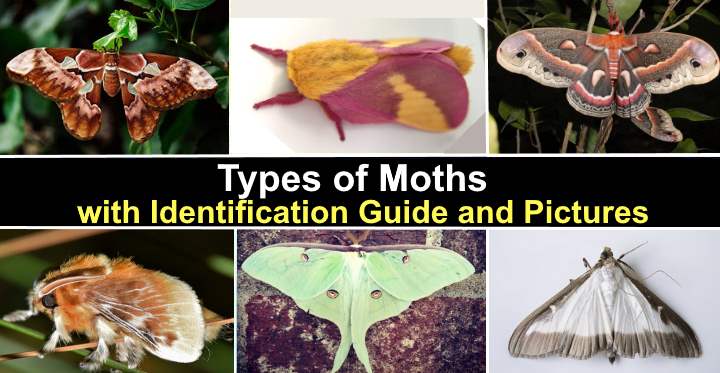
Many types of moths are beautiful nocturnal flying insects with colorful patterns on their large wings. Moths are more than the common brown moth that seems relatively drab compared to beautiful butterflies. Many moth species have stunning colors such as yellow, orange, pink, green, and red patterns. Some fascinating moth species can look like leaves or bark as they camouflage themselves on plants.
This article is a complete guide to identifying some of the prettiest moths you will see. You will learn how to identify brightly colored moths, fuzzy moths, and some of the largest moths in the world.
How to Identify Moths
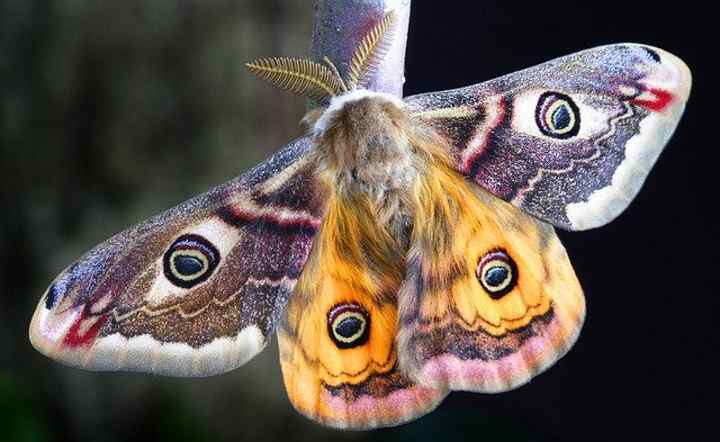
Moths can be identified by their feathery antennae, nocturnal activity and holding their wings parallel to the ground when resting
You can easily recognize moths by their antennae, wings, and activity.
First, moths are generally identified by their saw-edged antennae that give the long feelers a fuzzy appearance.
Second, moth identification is also possible by the way they place their wings when they land on objects. Moths tend to hold their patterned wings flat, parallel to the ground when resting. This feature of moths helps to tell them apart from butterflies. Most butterfly species hold wings upright when standing on objects.
The third way to identify moths is by when they are most active. Moths are generally seen fluttering in the air at nighttime or when it gets dusk. This nocturnal characteristic helps to identify moths from types of butterflies.
Facts About Moths
Moths are winged insects in the order Lepidoptera. There are approximately 160,000 species of moths in the world—around ten times the number of butterfly species. About 11,000 moth species are native to North America. Moths can range in size from a few millimeters to the largest species of moths with a wingspan of 10” (25 cm).
Moths are a class of insects in the phylum Arthropoda. Like all insects, moths have two antennae, six legs, a head, a thorax, and an abdomen. Moths and butterflies have four wings that almost always have delicate patterns on them. The majority of moths are grouped into five families—Arctiidae, Noctuidae, Geometridae, Saturniidae, and Sphingidae.
Most people are familiar with the common brown or gray moth. However, some moth species have spectacular wing colors and patterns. There are colorful moths such as orange and black moths, all-white moths, and pink and yellow moths. Many species of moths have characteristic brown or black patterns and a fuzzy body.
Like butterflies, moths start life as a caterpillar, or moth larvae.
A moth’s life cycle starts when the female moth lays eggs. After a few days, larvae or caterpillars hatch, and they voraciously gorge on plant matter to increase body size. Then during the pupal stage, the moth caterpillar metamorphoses into a moth. Depending on the moth species, it can take between a few weeks and a year for the moth to emerge from the pupa.
Identification of Moths vs. Butterflies
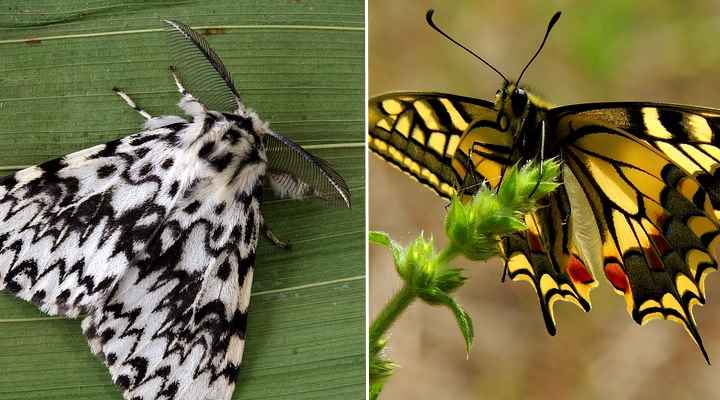
Moth antennae (left) vs butterfly antennae (right)
The main difference between moths and butterflies is the shape of their antennae. Moths generally have thicker, feathery and pointed antennae, whereas butterflies have thin antennae with small balls as the end. Other differences are that moths are active during dusk and nighttime, and butterflies are active during the day.
Types of Moths — Names, Pictures, and Identification Guide
Let’s look in detail at how to identify some of the coolest moths that come out and start feeding after dusk.
Rosy Maple Moth (Dryocampa rubicunda)
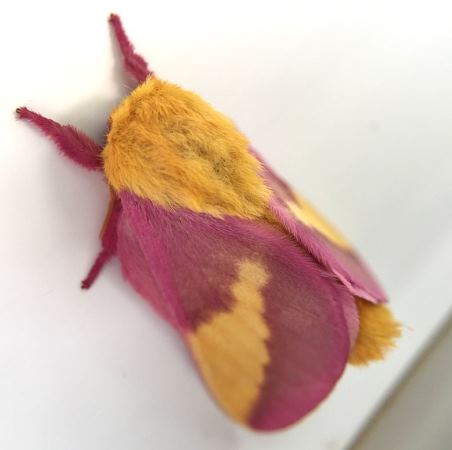
The beautiful fluffy rosy maple moth is easily identified by its colorful yellow and pink wings
The rosy maple moth is one of the most colorful and spectacular moths you will see. Native to North America, the furry rosy maple moth has brightly colored pink and yellow wings, pink legs and antennae, and a hairy yellow body. Rosy maple moths have a wingspan of between 1.25” and 1.75” (3 – 4.5 cm).
As the name suggests, rosy maple moths are found mainly on maple trees. The fluffy moths are common on the east coast of the US, from Florida in the south and north toward Canada.
The rosy maple moth belongs to the moth family Saturniidae. Before becoming a beautiful yellowish-pink moth the insect is green-striped mapleworm.
Rosy maple moth identification
Small, rosy maple moths are relatively easy to identify by their pink and yellow wings, yellow body, and pink antennae.
Luna moth (Actias luna)
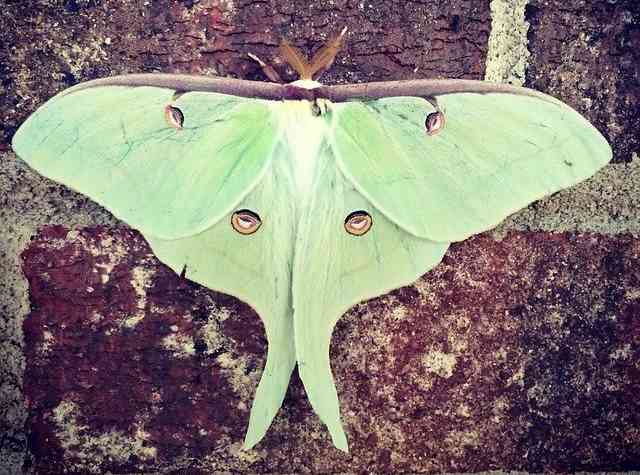
The green luna moth has tail-like hindwings and it looks like a leaf
The luna moth is a green moth that looks like a leaf. The four wings on the luna moth have lime-green coloring and small eye-like markings. The winged insects have a white body and a wingspan of 4.5” (11 cm). You will find the green luna moth in North America from Florida to Maine and throughout Canada.
Luna moth is a large type of silk moth in the family Saturniidae. The moth’s hindwings are long and tail-like, giving this green moth an attractive appearance. Before becoming a beautiful colorful moth, the insect is a green caterpillar with black spots.
Luna moth identification
To identify a luna moth, look for broad, light green wings that look like a leaf. It has characteristic tail-like wings
Blotched Emerald Moth (Comibaena bajularia)
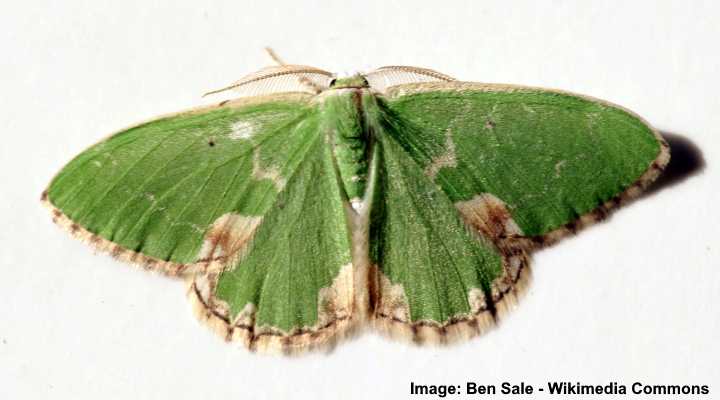
The small blotched emerald moth is mostly green with brown and beige patches
The blotched emerald moth is a small, pretty moth with green wings that have brown patches and a brown checkered edge. The blotched emerald moth’s name comes from beige blotches on the wings’ edges. The moth’s wingspan is 1.2” (3 cm). The blotched emerald moth is generally found on oak trees in deciduous forests in Europe.
The blotched emerald moth is classified in the insect order Lepidoptera and family Geometridae.
Blotched emerald moth identification
It can be hard to spot a blotched emerald moth because the moth looks like a leaf. Look for identifying features such as green wings with brown patches and thin, saw-like antennae.
Achemon Sphinx Moth (Eumorpha achemon)
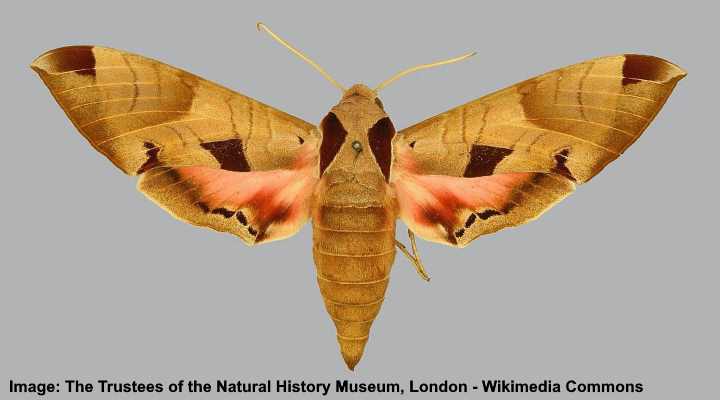
The Achemon sphinx moth is quite large with brown and pinkish patches
The achemon sphinx moth is a type of moth that looks like a brown leaf. The pretty moth has elongated triangular wings that are light brown with dark brown square patches. The underneath of the wings has a pinkish coloring. The achemon sphinx moth’s wingspan measures 4” (10 cm).
The pink and brown moth—achemon sphinx—belongs to the family Sphingidae. Before turning into a cool moth, the achemon sphinx is a green or reddish-orange caterpillar.
Achemon sphinx moth identification
Identify the achemon sphinx by its pointed, triangular brown and pink wings and plump body. You’ll notice that the moth’s body has similar color and brown markings as the wings.
Beautiful Wood Nymph Moth (Eudryas grata)
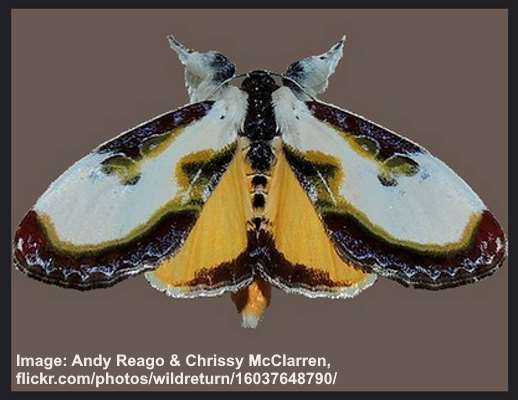
The beautiful wood nymph moth looks like bird dropping with its brown, white and yellow wings
The beautiful wood nymph moth has front wings that are brown and white and yellowish and brown hindwings. The wood nymph moth looks like bird droppings when it’s resting on trees and plants—an ingenious method of defense. Wood nymph moth wingspan is around 1.5” (4 cm). You’ll also see two thick furry antennae at the moth’s head.
Looking at pictures of this moth, it’s easy to see how it gets its name. The beautiful, rounded wings are mainly white with wide brown margins. The bright yellow wings only add to the prettiness of this brown and white moth. Before becoming a fuzzy moth, the wood nymph was a gray and orange striped caterpillar.
Beautiful wood nymph moth identification
Identify beautiful wood nymph moths by their small white, brown, and yellow wings. The Eudryas grata is the largest moth from the Eudryas species.
Purple Thorn Moth (Selenia tetralunaria)
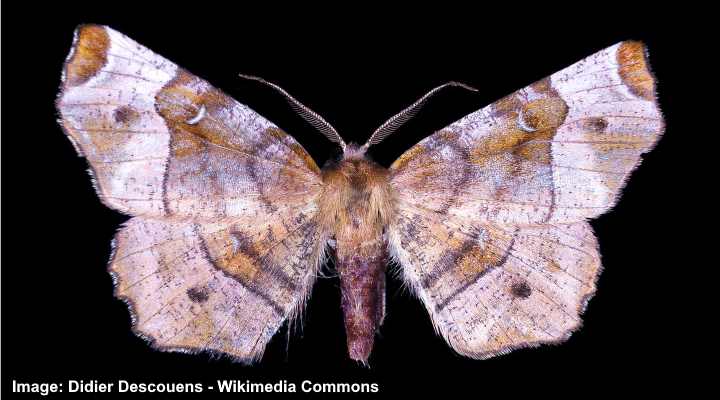
The purple thorn moth has beautiful brown-purplish patterns on its wings
The purple thorn moth is one of the coolest colored moths due to its purplish-brown wings, eye-like markings, and intricate patterns. The identifying mark of the purple thorn moth is the angular margins along the wing edges. Purple thorn moths have a wingspan of 2” (5 cm).
Purple thorn moths are colorful moths in the family Geometridae. The distinctive moths are native to Europe and are often found on black poplars, birches, alders, roses, and pear trees.
Purple thorn moth identification
To spot a purple thorn moth, look for purplish-brown wings that have ragged edges. The moth’s wings also have a characteristic white comma-shaped white mark on the forewing.
White-Striped Black Moth (Trichodezia albovittata)
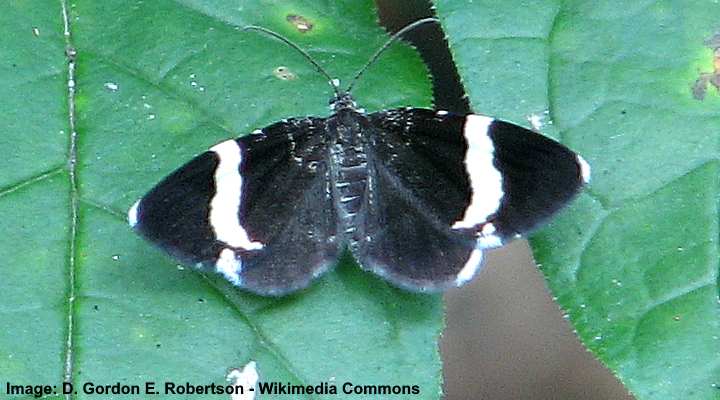
The small white-striped black moth has rounded wings with white tips
The white-striped black moth is an attractive winged insect with an identifiable white stripe on black wings. The native black moth has a wingspan of 0.8” (2 cm), making it a relatively small moth in North America. The black moth is found all the way from California to North Carolina.
The white-striped black moth is a member of the moth family Geometridae. You’ll find the moth larvae feeding on impatiens plants such as jewelweed, snapweed, and touch-me-not.
White-striped black moth identification
It’s easy to spot this distinct moth species by its velvety-black rounded wings with a thick white bar on the middle. Looking at pictures of the white-striped black moth, you’ll notice white wingtips.
Atlas moth (Attacus atlas)
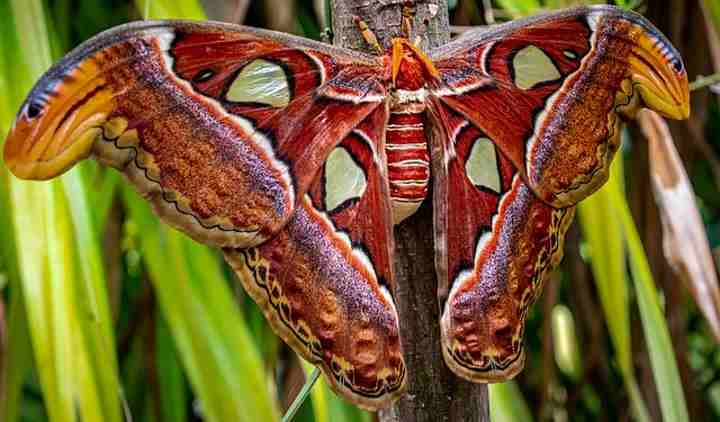
The atlas moth is a stunning type of large colorful moth with distinctive forewing tips
The atlas moth is classified as one of the largest moths in the world. The spectacular brown moth has brightly colored orange-brown wings with white triangular markings, black stripes, and yellowish patterned margins. The two antennae have long filaments, making them look like a fish skeleton. Atlas moths have a massive wingspan of around 10” (25 cm).
Atlas moths are identified in the moth family Saturniidae. The common name of the moth comes from Greek mythology because of the insect’s large size. In some languages, the moth’s name is snake’s head moth—referring to the unique shape of the forewings.
Atlas moth identification
With its large brown wings, white and yellowish markings, and rounded orange-brown body, it’s easy to identify the atlas moth. Look for the distinctive forewing tips that look like a snake’s head.
Common Brown House Moth (Hofmannophila pseudospretella)
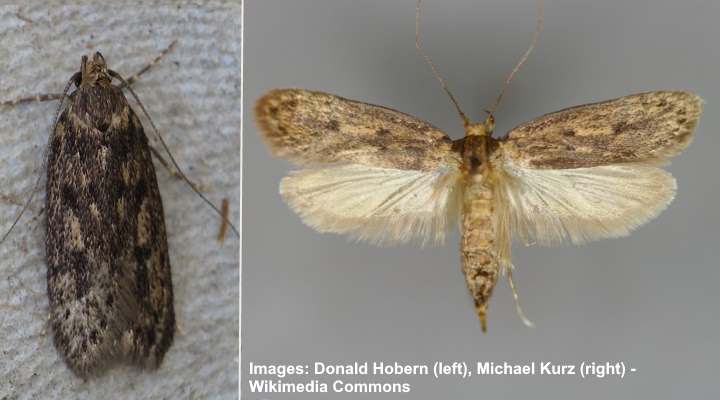
The common brown house moth has brown-grey speckled forewings and lighter hindwings without markings
The common brown house moth has two pairs of distinctive wings that look like dragonfly wings. The forewings measure about 0.8” (2 cm) and are dark gray-brown, and the hindwings are somewhat lighter. You’ll notice larger dark spots and more minor black-brown spots on the forewings. The long slender body has a similar color and markings to the forewings. The moth also has long, floppy antennae.
The common brown house moth belongs to the family Oecophoridae. In homes, the brown house moth larvae are destructive pests. The hungry worms chew through household materials and foodstuffs. These include cereal, seeds, furniture, and clothing.
Common brown house moth identification
The small brown moths have slender, elongated wings with rounded ends. The forewings are bronze-brown with blackish dots and specks, and the hind wings are a light tan color without noticeable markings.
Common Gray Moth (Anavitrinella pampinaria)
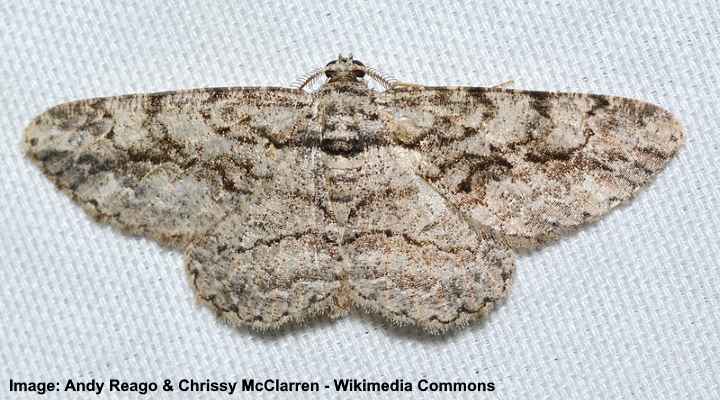
The common gray moth has light and dark grey patterns and is one of the most common moths in North America
The common gray moth has light gray wings with dark gray or black mottled patterns. The moth’s small body has similar gray-black markings as the wings, making it difficult to distinguish the body from wings. The small gray moth has a wingspan of 0.8” – 1.2” (2 – 3 cm).
Common gray moths are in the family Geometridae. The common gray moth is active at night in most regions of North America from April until October.
Common gray moth identification
Identify gray moths by gray wings that are heavily patterned with gray and black mottled markings. Pictures of the common gray moth show faint black lines extending from the forewings to hindwings.
Cecropia Moth (Hyalophora cecropia)
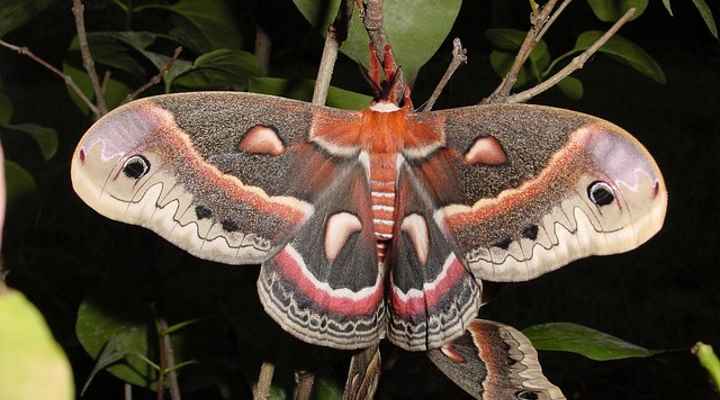
The large and colorful cecropia moth has stunning shades of brown, beige and orange patterns on its wings
The cecropia moth is the largest moth in North America. A type of giant silk moth, the cecropia moth has enormous orange-brown wings, a large orange body, and short furry antennae. The colossal brown moth has a wingspan of between 5” and 7” (12 – 18 cm).
Cecropia moths belong to the family Saturniidae. Before turning into a giant brown silk moth, the larvae are among the largest green types of caterpillars. The larvae are found on maple trees, birch trees, and cherry trees.
Cecropia moth identification
To identify the cecropia moth, look for the large brown wings with a black circle on the tips of the forewings. The edges of the wings have a wavy beige-yellowish, zig-zag pattern. There are also identifying orange-brown markings and spots of whitish, crescent-shaped spots.
Argent and Sable Black and White Moth (Rheumaptera hastata)
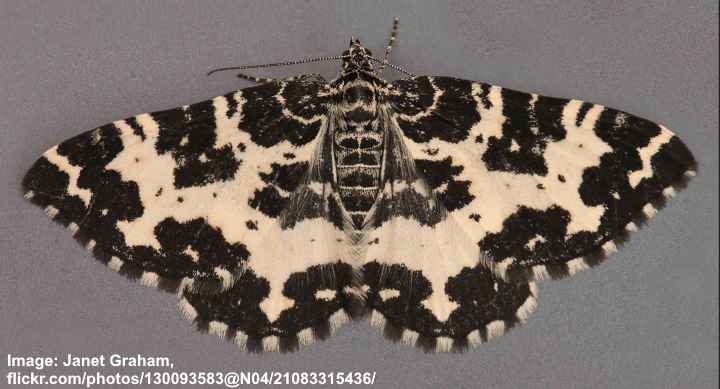
The Argent and Sable black and white moth is unique among moths as it’s active during the day and has distinctive black and white patterns
The argent and sable moth is a small black and white moth almost as beautiful as a butterfly. The unique feature of argent and sable is that it’s a day-flying moth. The black wings have white splashes and blotches on them. There is also a distinguishable black margin on the wings. The argent and sable wingspan is around 1.5” (3.8 cm).
Argent and sable moths belong to the moth family Geometridae. Before its pupal stage, the argent and sable moth is a small black caterpillar that feeds on tree leaves.
Argent and sable moth identification
Argent and sable moths are easy to identify because they are active during the day and have distinctive black and white wings.
Black Rustic Moth (Aporophyla nigra)
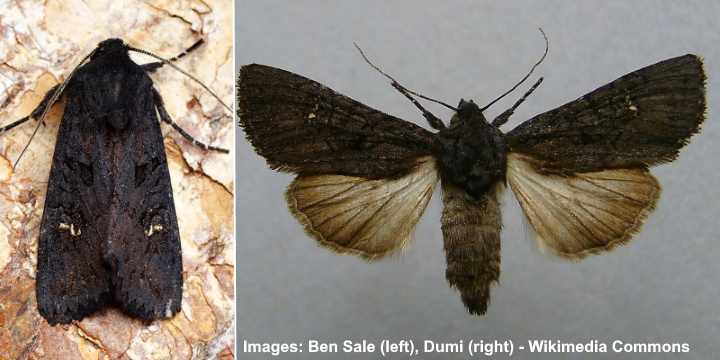
The black rustic moth has very dark forewings and lighter gray-brown hindwings
The black rustic moth has dark brown, almost black forewings and lighter grayish-brown hindwings. The black moth’s wingspan is between 1.5” and 2” (4 – 5 cm). When the moth is resting, the two forewings lay flat across the body, making the moth look like a black triangle.
Black rustic moths belong to the family Noctuidae. The black moths are native to Europe and North Africa and are active during September and October.
Black rustic moth identification
Identify black rustic moths by the pair of black forewings and a pair of brownish-gray hind wings. You’ll notice that the body is plump and long compared to the wing size.
Twin-Spotted Sphinx Moth (Smerinthus jamaicensis)
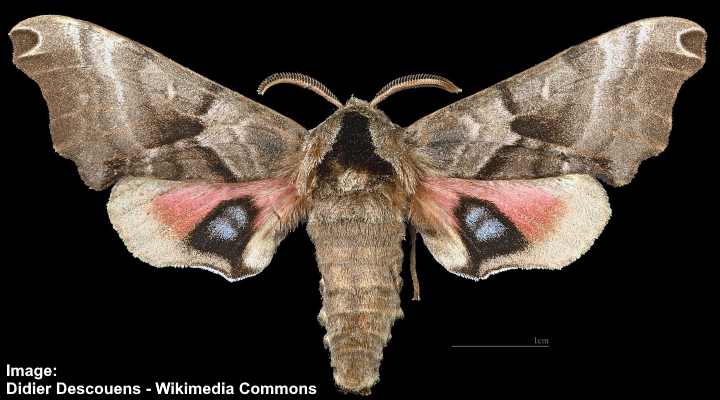
The twin-spotted sphinx moth can be identified by its pink and yellowish hindwings with blue eye markings
The twin-spotted sphinx moth is a pretty moth with beige-brown and white wings and pinkish-red and yellow markings. The North American native sphinx moth also has stunning blue eye spots on its hind wings. The twin-spotted sphinx moth has a wide, brown body and two curling fuzzy brown antennae at its head.
The twin-spotted sphinx moth has a large wingspan of 2” – 3” (5 – 8 cm).
Twin-spotted sphinx moths belong to the family Sphingidae. The moths are found from northern Florida to North Dakota and Arizona.
Twin-spotted sphinx moth identification
The distinct pink and yellow hind wings with blue eye markings make this brown moth species easy to identify. Additionally, the larger wedge-shaped forewings are yellowish-brown with shades of dark brown and white markings.
Io Moth (Automeris io)
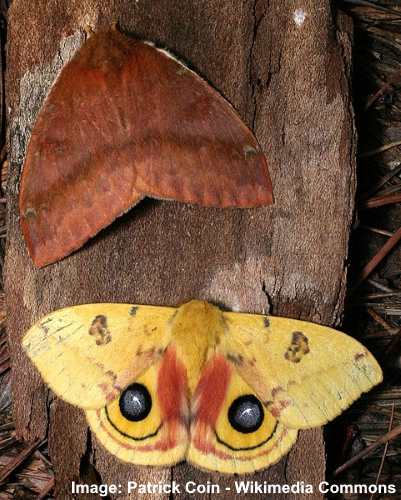
Io Moth (Automeris io): female (top) and male (bottom)
The Io moth is a type of yellow and orange furry moth with distinctive black eye markings on its hind wings. A member of the Saturniidae family, the yellow Io moth has a bright yellow hairy body and furry antennae. Female Io moths have reddish-brown forewings, giving the moths an orange appearance. The fluffy Io moth’s wingspan is 2.5” to 3.5” (6 – 9 cm).
Southern Flannel Moth (Megalopyge opercularis)

The fluffy southern flannel moth has furry body with brown wings and white edges
The southern flannel moth is a brown and white furry moth with six hairy legs and a fat furry body. The small fluffy moth is covered in fine hairs and has dark brown wings that gradually fade to white. You can identify the southern flannel moth by its orange thorax. Its wingspan is 1” to 1.5” (3.8 cm). Other names for the southern flannel moth include puss moth, tree asp, and woolly slug.
Isabella Tiger Moth (Pyrrharctia isabella)
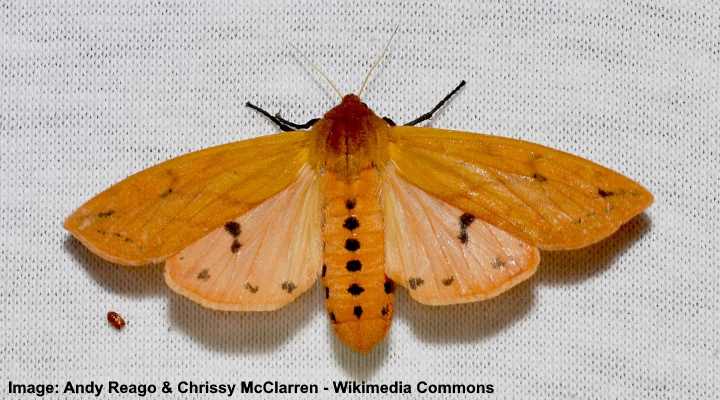
Isabella tiger moth has orange-yellow wings with black dots
The Isabella moth is a small yellow-orange moth with a furry orange body and wings with black spots. This tiger moth is also called the banded woolly bear, a native North American moth in the family Erebidae. The eye-catching orange moth has a wingspan of 2” (5 cm).
The Isabella moth is identified by its yellowish-orange stout body, small head, and light feathery antennae. These stunning moths rival butterflies when it comes to color.
Related articles:
